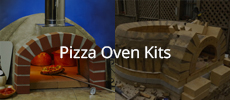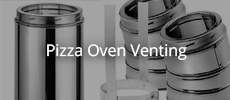Announcement
Collapse
No announcement yet.
WFO in Utrecht, the Netherlands
Collapse
X
-
The dome insulation, based on your threads will be ceramic blanket and maybe vcrete neither which are stucco, may be called render in you area of the world. When free water sublimates to steam the volume of water will increase by factor of 1500 times. So stucco (or render) if installed over dome prior to curing could build up enough pressure to crack the stucco/render. This is also why a vent at the apex of the dome is recommended. (You can search the blog for examples). Instead of an electric hot plate, I would just start out with some BB briquettes. This will get you temps up to about 200 F and you can cook some dutch oven meals while your at it.
-
If I built again I would probably put my blanket on before I started curing fires. I do have a rather large crack in the back of the oven and although I can't remember exactly when it opened up there was quite a temperature differential between the inside and un-insulated outside of the oven during firing. There will always be a differential when you start a fire but the oven will equalize more quickly with insulation. I started fires beforehand because I was anxious to see fire and had not figured out exactly how I was going to hold down my insulation. When I did insulate it was very breezy and keeping it in place was a challenge. Best to do that on a calm day if possible.
and had not figured out exactly how I was going to hold down my insulation. When I did insulate it was very breezy and keeping it in place was a challenge. Best to do that on a calm day if possible.
- Likes 1
Leave a comment:
-
-
Russel, thanks, I already found the Morgan superwool.Originally posted by UtahBeehiver View PostCurrent thought is having the dome insulated but not stucco coated during the curing. This will minimize the temperature differential between the inside and outside of the dome which will lessen the chance of thermal cracking (just be aware, all ovens will crack). 8" ID is correct for a 42" oven. You just need to wear PPE when you install the ceramic blanket regardless of brand. When the oven is complete it will be encapsulated and food will not come in contact. But I used Morgan Thermal Superwool and it has a non carcinogen rating it is also one of the largest producers of refractory materials.
Just due to my interpretations of the terms - when you say "dome insulated, but not stucco coated" Is the insulation = ceramic blanket + vermicrete layer, or do you consider the vermicrete layer the stucco layer.
Thanks!!!
MArko
Leave a comment:
-
Current thought is having the dome insulated but not stucco coated during the curing. This will minimize the temperature differential between the inside and outside of the dome which will lessen the chance of thermal cracking (just be aware, all ovens will crack). 8" ID is correct for a 42" oven. You just need to wear PPE when you install the ceramic blanket regardless of brand. When the oven is complete it will be encapsulated and food will not come in contact. But I used Morgan Thermal Superwool and it has a non carcinogen rating it is also one of the largest producers of refractory materials.
- Likes 2
Leave a comment:
-
So, managed to do a couple of rows more, and tonight, will try to close the rows on the entry arch
After it got dry, I just mounted a wire wheel on a drill, and started cleaning the inside of the oven (should have done that from beginning.
Interesting, as I am coming to these more vertical rows, the homebrew is definitely good. It needs to stay some 1 minute being held by the IT, than I put the next brick, squeeze it to the one that the IT is holding, and just transition the IT from one to another brick. Works like a charm, no need (yet) for those sticks to hold the bricks, they are in place.
Just went to the store, and I bought 20cm (approx 8'') inner diameter chimney. It is double walled, with some sort of isolation between the two walls of the chimney flue.
But with this isolation, the outer diameter of the chimney is 25cm (9.8""), seems really big. The commercial ovens that were on display there had approx 13-15cm max single wall chimneys, but they were also smaller, not the 42''. Also, I took 1.5meters of chimney, it should be enough, but I can always add.
Question for you all, they did not have the non-cancer inducing ceramic blanket. Will find one, but do you know any brand names / producer names for such a product. I know they are claiming, in case it does not fall in contact with the food, you should be OK. I intend to use this for the next many years.
Question 2, I also got a rope, that is used for the stove openings, and is rated for 550 degrees celsius. I intend to use this in the heat stop. Do you think this is enough of a rating, or it should be more. This will be just between the bricks of the entry arch and the gallery arch, not exposed to direct flame, and outside of the dome.
Hopefully finishing the dome in the next 3/4 days. Would like to finalize the dome and the galery before august.
JRPizza I have a question for you - I see that you have cured your oven, before the ceramic blanket and the isolation, is that the general consensus. I actually like the idea, it gives you the possibilty to repair some early forming cracks.
Salutations to you all!!!
Leave a comment:
-
Nice, this photo is clear.Originally posted by JRPizza View PostI bought some kevlar rope that is sold as gaskets for Green Egg type cookers. The kevlar can take the heat and is supposedly not toxic if anything falls onto a cooking or prep surface. If you zoom in on the picture you can see the heat break gap between the dome arch and my rear vent arch. I can't remember if I stuffed the rope in as I laid the bricks or pushed it in afterwards.
PS, grew up a huge Clapton fan - Uncle was a DJ in Los Angles and gave me a promotional copy ofDisraeli Gears - was one of my first few albums.
Yes, huge fan of Eric Clapton. He was 2 weeks ago in Amsterdam, but could not see him, had some other plans, he still puts a hell of a show.
I like his entire oeuvre, but my favorite is the early Cream / Blind Faith / Derek and Dominos years, he was a killer back than. Still, some of the last albums, pure blues, I think he is getting back to the roots.
I was on a concert of him and Steve Winwood, some 10 years ago, I think they did a whole world tour together, one of the best concerts ever!.
I am waiting 2 days before laying another row, as this one will close over the opening of the dome. I hope to send update pictures soon!
Cheers!
Marko
Leave a comment:
-
I bought some kevlar rope that is sold as gaskets for Green Egg type cookers. The kevlar can take the heat and is supposedly not toxic if anything falls onto a cooking or prep surface. If you zoom in on the picture you can see the heat break gap between the dome arch and my rear vent arch. I can't remember if I stuffed the rope in as I laid the bricks or pushed it in afterwards.
PS, grew up a huge Clapton fan - Uncle was a DJ in Los Angles and gave me a promotional copy ofDisraeli Gears - was one of my first few albums.1 PhotoLast edited by JRPizza; 06-27-2022, 06:06 PM.
Leave a comment:
-
Originally posted by JRPizza View PostLots of builders (using bricks) utilize a front and rear arch framing the chimney opening. The link below shows how I did mine. I cut my rear arch bricks so that they would extend a little back over the dome arch giving me a little more bonding area for the mortar and a nice horizontal surface for my insulating rope in the heat gap. The interesting part to figure out now is how do you want to transition to the opening for your chimney. Several different ways to do it - I looked at the different designs here on the forum and the one I did just "clicked" in my mind and was something I could visualize doing.
https://community.fornobravo.com/for...372#post386372
JR, thanks, was looking through your build, looking magnificent. I will try to do the serpentine transition for the middle part of the flue gallery, I like that design.
also the flue arch that goes over the dome openig arch, very good!
still trying to figure out how did you do the isolation in the heat stop.
Leave a comment:
-
For your mortar - what I found worked for me was to just wipe my bricks with a damp sponge to where I could see a color change along the edge of about 1/4 inch or less. Then I used sloppy wet mortar. The bricks draw in the water from the mortar and it really grabs. You will need the technique as you get towards the top of the dome so the mortar will help hold the bricks in place during curing.
Leave a comment:
-
Lots of builders (using bricks) utilize a front and rear arch framing the chimney opening. The link below shows how I did mine. I cut my rear arch bricks so that they would extend a little back over the dome arch giving me a little more bonding area for the mortar and a nice horizontal surface for my insulating rope in the heat gap. The interesting part to figure out now is how do you want to transition to the opening for your chimney. Several different ways to do it - I looked at the different designs here on the forum and the one I did just "clicked" in my mind and was something I could visualize doing.
I've been working on my oven for a little while and have been debating starting a build thread, as I probably won't have much to add in terms of artistry or inventiveness over the excellent work already posted on this forum. That said, I thought I would share what I have done and hopefully continue to get
Leave a comment:
-
And, finished the next row, I am doing now the transition over the arch
Leave a comment:
-
david s and
UtahBeehiver
Thanks for the homebrew advice, just finished lathering it all up
Works really well, but already at the drying, I noticed some cracks. I presume this is from not soaking it to much. I tried to soak them, but was doing this at the end of 2 warmest days of this year, I presume the bricks were really dry
As it was not fully set, I just took out a sharp knife, and removed most of the ones that did not set. It was not a lot, but there were 3 on the entry arch, that I did not like. I will make sure to wet it completely, and than re-fill with the homebrew, does anyone have any other advice?
Leave a comment:
-
Hey, JRPizza,
You are correct, a picture is worth a thousand words. So, I just found out in the build of Mongota, what I would like to do:
So you see that the arch of the flue galerry is on both sides. I do not know if this WFO has a heat stop.
The other option would be that the flue opening begins immediately, without "completing" the arch that next to the dome opening.I just now tried to find some examples of this kind of flue opening, but I see I cannot find, so I might have just imagined it.
Interesting to find out that smoothening out the transition helps so much with the way the chimney draws smoke
Leave a comment:
-
Above you talk about two alternate designs but I can't picture exactly what you are asking - if you have links showing pics it might be easier to get opinions. Some have built entirely independent vent arches, meaning there are front and rear vent arches that hold the chimney structure that do not touch the dome arch. Others have had a heat break at the bottom but either supported the upper portion of the rear vent arch on top of the dome arch or used the dome arch as the rear arch of the vent structure. I think all the options should be similar for air flow if you provide similar opening sizes. They will change depth of the vent (from longest to shortest) and theoretically change the amount of heat transferred from the dome to vent although we really don't have data to quantify how much.Last edited by JRPizza; 06-23-2022, 10:41 AM.
Leave a comment:





Leave a comment: